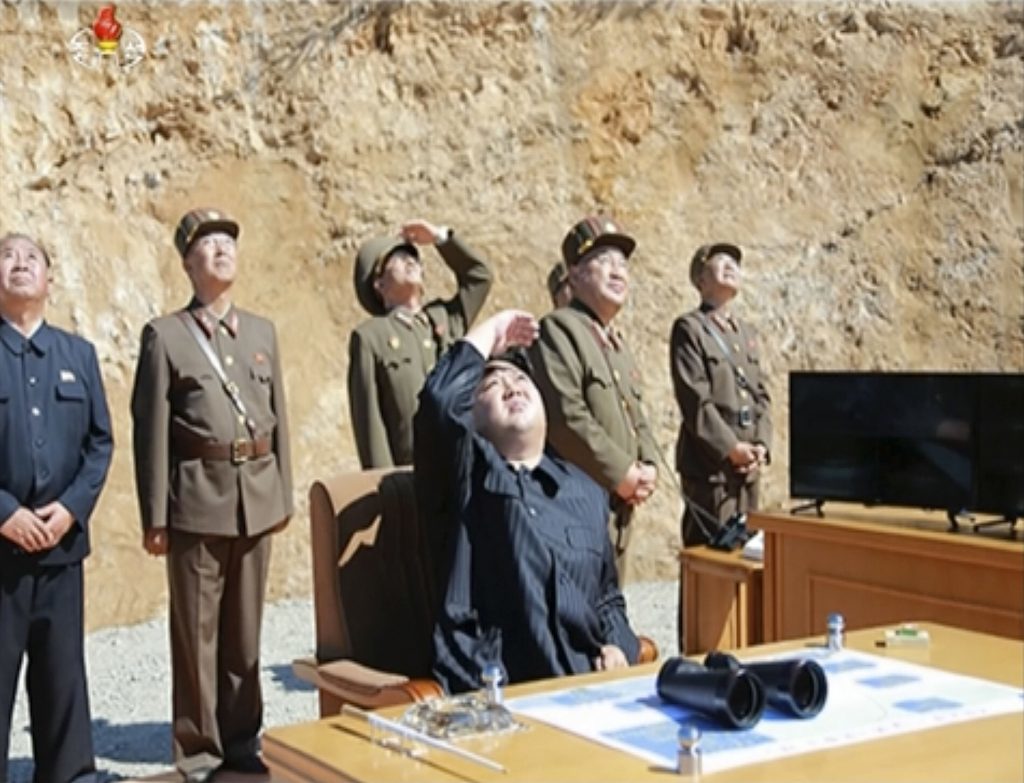
Donald Trump has threatened North Korea with “fire and fury like the world has never seen” after suggestions the reclusive communist state has cleared a final hurdle to being able to strike the United States with a nuclear missile.
And Pyongyang fanned the flames further by saying said it was examining its operational plans for attacking Guam, a US territory about 2,100 miles away and home to Andersen Air Force Base, in order to contain American military activity there.
In a statement distributed by the state-run news agency on Wednesday, the North Korean army said it was studying a plan to create an “enveloping fire” in areas around Guam with medium to long-range ballistic missiles.
Although it was not clear if US president Mr Trump and the Koreans were responding directly to each other, the heightened rhetoric added to the potential for a miscalculation that might bring the nuclear-armed nations into conflict.
Mr Trump’s stern words to the camera at his golf course in Bedminster, New Jersey, came hours after reports indicating North Korea can now wed nuclear warheads with its missiles, including those that may be able to hit the American mainland.
The isolated and impoverished dictatorship has strived for decades to have the ability to strike the US and its Asian allies, with the pace of its breakthroughs already having far-reaching consequences for stability in the Pacific and beyond.
The nuclear advances were detailed in an official Japanese assessment and a Washington Post story that cited US intelligence officials and a confidential Defence Intelligence Agency report.
The US now puts the North Korean arsenal at up to 60 nuclear weapons, more than double most assessments by independent experts, according to the Post.
“North Korea had best not make any more threats to the United States,” said a stern-looking Mr Trump.
“They will be met with fire and fury like the world has never seen.”
The remarks appeared scripted, with Mr Trump glancing at a paper in front of him.
They evoked former president Harry Truman’s announcement of the US atomic bomb dropped on Hiroshima, Japan, in 1945, in which he warned of “a rain of ruin from the air, the like of which has never been seen on this earth”.
The Trump administration considers North Korea to be America’s greatest national security threat and tensions have steadily escalated this year.
Pyongyang responded angrily to the United Nations Security Council’s adoption this weekend of new, tougher sanctions spearheaded by Washington, following ground-breaking long-range missile tests last month that showed the North could potentially reach the continental United States with its missiles.
The newly-revealed US intelligence assessment indicates those missiles can carry nuclear warheads.
Condemning the UN sanctions, the North warned: “We will make the US pay by a thousand-fold for all the heinous crimes it commits against the state and people of this country.”
For North Korea, having a nuclear-tipped missile that could strike America would be the ultimate guarantee against invasion by its superpower adversary and is an ambition decades in the making.
The secrecy of the North’s nuclear programme and the underground nature of its test explosions make it very difficult to properly assess its claims, but the new assessments from Japan and the US suggest that doubts over the North’s abilities are receding.
In an annual report, Japan’s Defense Ministry on Tuesday concluded that “it is possible that North Korea has achieved the miniaturisation of nuclear weapons and has developed nuclear warheads”.
Japan, a key US ally, is a potential, front-line target of North Korean aggression.
It is unclear how North Korea’s new capabilities will immediately affect how the US approaches the country’s regular missile launches and occasional nuclear tests.
The US military has never attempted to shoot a North Korean missile out of the sky, deeming all previous tests to pose no threat to America. But the US could consider military action if the threat perception changes.
Last month’s tests of intercontinental ballistic missiles highlighted the growing threat.
While those missiles landed at sea near Japan, both were fired at highly lofted angles.
Analysts said the weapons could reach Alaska, Los Angeles or Chicago if fired at a normal, flattened trajectory.
North Korea threatened to hit Guam with its Hwasong-12 missiles, which it says can carry a heavy nuclear warhead and before the two ICBM launches had demonstrated the longest potential range of the missiles test-fired by the North.
But Pyongyang is still believed to lack expertise to allow a missile to re-enter the Earth’s atmosphere without burning up and another work in progress is the ability to strike targets with accuracy.
Meanwhile security and defence chiefs on Guam said there was no imminent threat to people there or in the Northern Mariana Islands.
Guam’s homeland security adviser George Charfauros urged calm and said officials were confident “the US Department of Defence is monitoring this situation very closely and is maintaining a condition of readiness”.
Recommended for you
